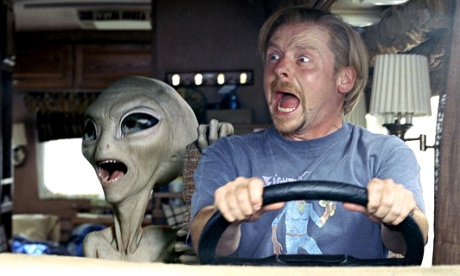
“Am I harvesting farts?” - Paul
Simon Pegg, Nick Frost and Edgar Wright have made three films together; each of them sly, kinetic, expansive, reference-filled genre pieces that succeed because their combined love of the source material is so gloriously pronounced. And, then, sometimes they don’t make films together. This is where the wheels tend to fall off.
Leave Frost to his own devices and he makes things like Cuban Fury. Leave Pegg to his own devices and he makes things like A Fantastic Fear of Everything. Leave Wright to his own devices, and we’ll never find out what sort of things he makes because Marvel will bin him off right before filming starts. Paul, however, hovers somewhere between these extremes – Pegg and Frost wrote and starred in it, but Wright was nowhere to be seen. When it was released in 2011, this arrangement made it hard for critics to reach a consensus; was Paul great because Pegg and Frost were involved, or was it disappointing because Wright wasn’t? With the benefit of hindsight, the answer is now clear. It’s a little bit of both.
“This is America. Kidnapping a Christian is worse than harbouring a fugitive” - Paul
To be fair, the first thing you notice about Paul is Edgar Wright’s absence. The camera moves a little slower, each scene has a little more breathing space at the end. And, unlike Shaun of the Dead or The World’s End, there’s no bigger point to the film. A couple of guys find an alien, have a couple of laughs and that’s about it. Where The World’s End had a heartbreaking subtext about the dangers of clinging to a vanished youth, this has nothing of the sort. Nick Frost’s character is a walking dearth of subtext. He’s barely even got any text. His character traits are essentially "a bit sad sometimes" and "quite likes looking at swords".
But that’s sort of the point. Where Wright has had difficulty flattening out his genius to become more palatable for Hollywood – Scott Pilgrim v The World flopped, and we all know what happened to Ant-Man – Paul is more or less as audience-friendly as it comes. It’s a sun-dappled, widescreen, relatively sincere love letter to Hollywood conventions, and this could be why it made as much money as The World’s End and Scott Pilgrim combined.
“Just because your truth isn’t the true truth doesn’t mean there is no truth, Ruth” - Graeme
Like Wright’s films, Paul is crammed with references, but for the most part they’re just references for the sake of references. Some of them work, some of them are far too blunt and some of them have dated incredibly in the three years since it was released. It’s a scattershot approach, and this also extends to the film’s casting policy, which seems to involve filling the thing with enough cameos to paper over the gaps in the script. Jane Lynch is in there. Jason Bateman is in there. Jeffrey Tambor and Bill Hader and David Koechner and Sigourney Weaver are in there too; none of them really doing much but drawing attention away from how slight the story is.
However, despite being much less ornate than an Edgar Wright film, Paul still has traces of the old verve. Making the alien the crux of all extraterrestrial culture of the last 60 years (with a hotline to Steven Spielberg) is a very nice touch. Also, framing the entire film around Blythe Danner’s side character – a girl who Paul met and abandoned as a child, only to grow up bitter and isolated as a result – shows a level of emotional depth that might not have been present had Paul been written by anyone else. Watching Paul back for this piece, I timed the big Danner scene. It lasts little over a minute, but it’s the centrepiece of the entire thing. Without that minute, Paul is a caper. With it, it’s a film with real heart.
Paul has much less artistry – but much more commercial appeal – than an Edgar Wright film. Like I said, it’s a little bit great and a little bit disappointing. •
Notes
• Or maybe it just took loads of money because Seth Rogen’s in it. I mean, let’s not overthink this or anything.
• One cameo I do approve of – Todd from Breaking Bad. Even though he appeared in this before he started filming Breaking Bad.
• I’m starting to think that the key to making a successful film is to have an animated character perform a completely unnecessary dance sequence in it.
• Is the only film ever made to explicitly reference Capturing the Friedmans?
• I really liked the twist where the woman who was obviously Sigourney Weaver all along turned out to be Sigourney Weaver.
• Simon Hattenstone interviews Pegg and Frost

